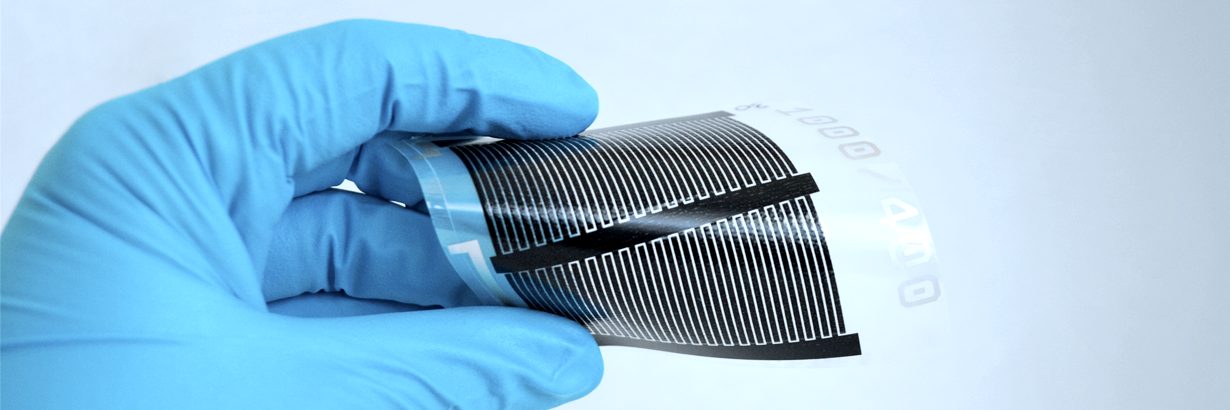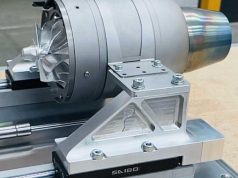The Internet of things (IoT) relies on continuous data collection from a network of sensors over time. Whilst some sensors can be wired, some must be remote from a power network and should be able gather and transmit their data wirelessly.
These wireless sensors need a reliable power source able to remain operational for extended periods of time, ideally for several years. Such a power source must be low-cost, compact, and able to fit into the form factor of the sensor.
Power sources for thin wireless IoT sensors are typically based on bulky and non-rechargeable batteries or energy harvesting systems relying on intermittent energy sources such as light, pressure variation, or temperature variation.
Rechargeable batteries combined with such an energy harvester would be very appealing in this context to compensate both the discharge of the battery over time and the irregular nature of the energy harvester. Printed batteries offer several advantages including mechanical flexibility, compact dimensions, and low production costs.
In the past, several companies have been producing and selling printed batteries, but no rechargeable printed battery solution has been commercialized until now. In this article, we present a novel printed battery solution that directly addresses this challenge. We will discuss its structure, function, specifications, and the multiple possible applications we foresee for rechargeable printed batteries.
Printed batteries
Printed electronics is an innovative production method offering numerous advantages. It is simple, cost-effective, and environmentally friendly. Components are printed using organic inks made from soluble polymers and particle dispersions. Printing processes such as inkjet or screen printing enable high-volume production at low costs.
Different materials such as metals, semiconductors, or dielectrics can be chosen and formulated as printable inks, enabling a variety of different functions to be achieved. These inks can be printed on a large scale, deposited on a variety of flexible or rigid substrates at relatively low temperatures, and subsequently integrated into many industrial or consumer products. Printed electronics is a technology ideally suited for the manufacturing of sensors on flexible substrates. This enables them to be used to great effect in situations lacking the space for conventional sensors.
The same printing technology can be applied for battery production. However, it has only recently become possible to print rechargeable batteries. This innovative printable battery technology was developed by Evonik in partnership with InnovationLab. The technology is called TAeTTOOz and has now been acquired by InnovationLab for upscaling and mass production.
How it works
This state-of-the-art rechargeable printed battery technology is based on redox-active polymers and conventional printing methods can be used to produce thin, flexible batteries that can store electrical energy without requiring metals or metallic compounds in their storage system. Importantly, battery cells produced using TAeTTOOz technology do not require a liquid electrolyte to function, which inherently eliminates the risk of leakage and subsequent hazards.
In conventional Li-ion batteries (Figure 1, left), only the small Li+ cations move in and out of the electrodes on either side of the battery in a process known as ‘intercalation’. A polymer-based battery works differently (Figure 1, right). Here, both anions and cations move within the electrolyte during cycling.
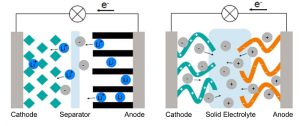
The polymer battery technology relies on redox-active organic molecules (polymers) whose redox states can be reversibly changed during the charging and discharging phases. Essentially this means that the redox polymer can undergo both a loss of electrons (oxidation) and a gain of electrons (reduction), with both processes being reversible.
TAeTTOOz batteries have two polymer-based conductive materials that are used as cathode and anode inside the battery, and a third ionic material that functions as a solid-state electrolyte (Figure 2). The cathode and anode materials are optimized to chemically store electric charges supplied from an external power source. This is achieved by a change of their redox state under a given loading voltage during the charging process.
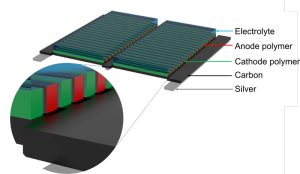
When a discharge voltage is applied, the initial redox state is reversibly restored, and power can be drawn from the battery. The solid-state electrolyte ensures electrical charge compensation in the battery by means of ionic mobility.
Production
The inks are water-based and can be formulated to meet customers’ specific needs, and do not require the use of toxic or CMR (carcinogenic, mutagenic, or toxic for reproduction) solvents. Due to the non-toxic nature of these organic inks, the printed products are compatible with common waste: Rechargeable batteries that are disposable!
To match specific printing needs, these inks are characterized in terms of their particle size, stability and rheology (i.e. flow characteristics). Combining these inks with printed conductive traces on a substrate allows both the batteries and the associated charging and discharging circuitry to be printed in a relatively small number of printing steps. Flexible substrates that can be used include foils made from polyimide (PI), polyesters (PET, PEN) or thermoplastic polyurethanes (TPU).
Due to the interesting fact that the battery does not actually hold any voltage prior to its first charge, subsequent production processes such as picking and placing of components are possible without any risk of overvoltage damage. These batteries can be printed from “start-to-finish” on standard screen-printing presses either in a full roll-to-roll continuous production mode or in sheet-to-sheet mode.
The lateral dimensions of printed batteries typically range from 1 to 20 cm, and the overall thickness does not exceed 0.5 mm. These batteries can, of course, also be stacked, folded, or rolled to design 3D objects for integration into existing systems.
The use of universal printing techniques enables customized batteries in different sizes to be fabricated. The size of printed batteries can vary from a few cm² to several m² with certain performance limitations in the case of extreme sizes.
Applications and customization
One of the major applications for the TAeTTOOz battery technology is its combination with a sensor or sensor array coupled with one of various energy harvesting components to create a fully autonomous, self-powered unit for IoT applications. The same principle can be utilized in signage or other similar devices.
Several ‘self-powered autonomous sensor unit’ projects are ongoing with our customers and partners, both from industry and academia, in which a printed rechargeable battery is combined with a temperature or moisture sensor is combined with a solar cell, a printed RF-harvesting antenna or a piezoelectric material. This technological concept has already been successfully applied and proven with the use of printed organic photovoltaic (OPV) solar cells.
The batteries technical specifications are defined by the chosen layout. Battery capacities from 0.1 to 0.2 mAh/cm² at an operating voltage of 1.2 V are typically achieved. The mentioned capacity and voltage determine the target applications. Obviously, they are too low to drive bright LEDs or heaters but optimal for low-power applications such as the powering of sensors in smart labels and patches.
Due to the screen-printing process, there is full freedom of cell design (Figure 3), with vertical or coplanar designs entirely possible. To achieve higher voltages, the printing technology enables several cells to be connected in series (Figure 3, right). For example, connecting two cells in series provides 2.4 V. The number of printing steps remains constant for a coplanar layout and increases in vertically stacked designs.
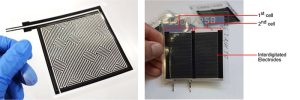
Reliability and general characteristics
Until now, these batteries have been primarily used in demonstration setups and for R&D purposes. The batteries have now been fully characterized in terms of their performance under various loading conditions, with self-discharge and cyclical measurements recorded. The achieved battery capacity is approaching the theoretical maximum achievable with the materials used – currently, it sits at about 70 % to 80 % with printed batteries.
The performance and reliability of printed batteries depends on a multitude of factors, including the printing geometry, the printing machine used, the resulting printed layer thickness and reliability, battery configuration, substrate, encapsulation, etc.
The cycling stability of the anode and cathode materials exceeds 500 cycles for above 80 % capacity retention, when used as individual materials in button cell batteries. Long term stability crucially depends on the utilized encapsulation technology. InnovationLab will be providing more information shortly, following the full completion of the technology transfer from Evonik.
Conclusion
Printed batteries are thin, lightweight, and flexible. They can provide a cost-effective solution for industrial wireless sensors and other IoT applications. The new TAeTTOOz technology enables flexible, rechargeable solid-state batteries to be printed on industrial scale, with Heidelberg Printed Electronics as InnovationLabs manufacturing partner. These printed batteries are also notably safer and environmentally friendlier than traditional metal-based batteries.
Soon, InnovationLab will supply both the printing materials and the know-how for the design, printing, and characterization of printed batteries. The company will also produce and sell its proprietary range of printed batteries to its customers, enabling the design-in and use of printed rechargeable batteries across industry.
For more information about InnovationLab, please visit www.innovationlab.de/en/printed-electronics/.
Subscribe to our Newsletter
3DPResso is a weekly newsletter that links to the most exciting global stories from the 3D printing and additive manufacturing industry.



